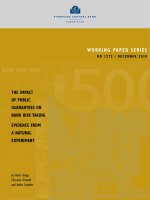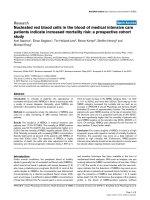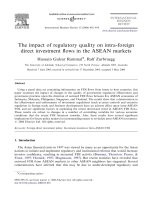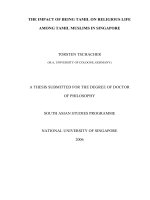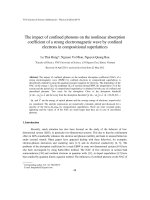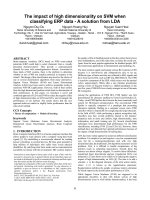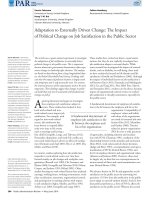The impact of medical tourism on colorectal screening among Korean Americans: A community-based cross-sectional study
Bạn đang xem bản rút gọn của tài liệu. Xem và tải ngay bản đầy đủ của tài liệu tại đây (403.04 KB, 10 trang )
Ko et al. BMC Cancer (2016) 16:931
DOI 10.1186/s12885-016-2965-y
RESEARCH ARTICLE
Open Access
The impact of medical tourism on
colorectal screening among Korean
Americans: A community-based
cross-sectional study
Linda K. Ko1*, Victoria M. Taylor1, Jihye Yoon2, Wade K. Copeland2, Joo Ha Hwang3, Eun Jeong Lee4
and John Inadomi3
Abstract
Background: Colorectal cancer (CRC) remains the most commonly diagnosed cancer among Korean Americans
(KAs) in part due to low screening rates. Recent studies suggest that some KA patients engage in medical tourism
and receive medical care in their home country. The impact of medical tourism on CRC screening is unknown. The
purpose of this paper was to 1) investigate the frequency of medical tourism, 2) examine the association between
medical tourism and CRC screening, and 3) characterize KA patients who engage in medical tourism.
Methods: This is a community-based, cross-sectional study involving self-administered questionnaires conducted
from August 2013 to October 2013. Data was collected on 193 KA patients, ages 50–75, residing in the Seattle
metropolitan area. The outcome variable is up-to-date with CRC screening, defined as having had a stool test (Fecal
Occult Blood Test or Fecal Immunochemical Test) within the past year or a colonoscopy within 10 years. Predictor
variables are socio-demographics, health factors, acculturation, knowledge, financial concerns for medical care costs,
and medical tourism.
Results: In multi-variate modeling, medical tourism was significantly related to being up-to-date with CRC
screening. Participants who engaged in medical tourism had 8.91 (95% CI: 3.89–23.89) greater odds of being up-todate with CRC screening compared to those who did not travel for healthcare. Factors associated with engaging in
medical tourism were lack of insurance coverage (P = 0.008), higher levels of education (P = 0.003), not having a
usual place of care (P = 0.002), older age at immigration (P = 0.009), shorter years-of-stay in the US (P = 0.003), and
being less likely to speak English well (P = 0.03).
Conclusions: This study identifies the impact of medical tourism on CRC screening and characteristics of KA
patients who report engaging in medical tourism. Healthcare providers in the US should be aware of the
customary nature of medical tourism among KAs and consider assessing medical tests done abroad when
providing cancer care.
Trial registration: Not applicable.
Keywords: Colorectal cancer screening, Medical tourism, Korean Americans
* Correspondence:
1
Division of Public Health Sciences, Fred Hutchinson Cancer Research Center,
Department of Health Services, University of Washington School of Public
Health, 1100 Fairview Ave. N, M3-B232, Seattle, WA 98109-1024, USA
Full list of author information is available at the end of the article
© The Author(s). 2016 Open Access This article is distributed under the terms of the Creative Commons Attribution 4.0
International License ( which permits unrestricted use, distribution, and
reproduction in any medium, provided you give appropriate credit to the original author(s) and the source, provide a link to
the Creative Commons license, and indicate if changes were made. The Creative Commons Public Domain Dedication waiver
( applies to the data made available in this article, unless otherwise stated.
Ko et al. BMC Cancer (2016) 16:931
Background
The US Preventive Services Task Force recommends
screening for colorectal cancer (CRC) using stool testing
(Fecal Occult Blood Test or Fecal Immunochemical
Test) annually, flexible sigmoidoscopy every 5 years with
stool test every 3 years, and colonoscopy every 10 years,
beginning at age 50 and continuing until age 75 [1].
Over the last two decades, there has been a steady increase in the use of CRC screening in the United States
[2]. Prevention and early detection of CRC through the
use of screening tests have resulted in better prognosis
and longer survival and reduced disease incidence and
mortality [1–3]. The increase in CRC screening use,
however, has not occurred evenly across the US population, and minority and immigrant populations still disproportionately underutilize CRC screening. One such
minority and immigrant population is Korean Americans
(KAs) [4]. CRC incidence rates have steadily increased
among KAs since 1990 [2, 4, 5]. Over the last 15 years,
CRC has been the most commonly diagnosed cancer
among KAs, [2, 4, 5] and CRC screening use is low in
this population [4–7].
Research shows that KAs who do not undergo a CRC
screening test are largely uninsured, often recent immigrants, and frequently have limited English proficiency
[6–8]. These factors position them to be disconnected
from the US healthcare system and the larger public
health efforts directed at promoting CRC screening
among underserved populations. In addition, some KAs
seek healthcare from KA doctors who speak Korean;
many of these professionals received their training in
South Korea and may not adhere to the CRC screening
guidelines in the US [9, 10].
A recent body of evidence suggests that some KAs
may be engaging in medical tourism and traveling to
their home country to receive preventive care including cancer screening [11]. For example, a study using
qualitative methodology with focus groups found that
some KA women reported traveling to their home
country to receive screening for breast and cervical
cancer [11]. The Centers for Disease Control and Prevention have reported that US patients who engage in
medical tourism are largely immigrants who return to
their home country for care [12]. A recent report from
the Korea International Medical Association noted that
medical tourism has increased as a result of the foreign patient legislation law in 2009 [13]. This law
enables foreign patients and their families to obtain
longer-term medical visas and authorizes local hospitals to market medical tourism to foreign patients [13].
As a result, medical tourism has emerged as a vibrant
industry, establishing South Korea as a host country
for providing quality, affordable healthcare services to
KAs [14].
Page 2 of 10
An understanding of medical tourism is important
because it could potentially have an impact on KA patients’ preventive care, follow-up, and treatment for
CRC as well as other medical conditions. In South
Korea, although a stool test (Fecal Occult Blood Test
or Fecal Immunochemical Test) is usually the first
choice of recommendation among South Korean providers, colonoscopy is readily available for those who
can pay out of pocket and is done every 5 years [15].
In addition, the cost of receiving a colonoscopy in
South Korea is approximately 2.3% of the cost of colonoscopy in the US; this lower cost may encourage
individuals to get screened for CRC as it somewhat
removes a financial barrier [16]. However, we know
little about the occurrence of medical tourism among
KAs or the extent to which medical tourism is associated with getting a CRC screening test among KAs.
Additionally, no previous studies have characterized
the patients who choose to engage in medical tourism
or identified factors that play a role in KAs’ decision
to engage in medical tourism. The purpose of this
study is to examine the topic of medical tourism and
CRC screening including 1) the frequency of medical
tourism, 2) the association between medical tourism
and CRC screening in relation to established CRC
screening predictors, and 3) characteristics of KA patients who engage in medical tourism.
Methods
Study Overview
This cross-sectional, observational study was conducted
in the Seattle metropolitan area of Washington State
(WA). In WA, Asians are the second largest minority
population and KAs are the fourth largest Asian group;
most WA KAs reside in the Seattle metropolitan area
[17]. The survey was administered over a 3-month
period from August 2013 to October 2013. Our three
data collectors were all bilingual KA women. Participants completed an in-person, 10–15 min, selfadministered paper-and-pen survey in their preferred
language (Korean or English). All the participants chose
to complete their survey in Korean. Participants received a gift bag with health promotion materials as a
token of appreciation for their time. Study materials
were translated from English into Korean using standard forward translation methods. This study was approved by the Institutional Review Board and the Ethics
Committee of the Fred Hutchinson Cancer Research
Center (IRB # 8051). Verbal consent was obtained from
all the study participants prior to participation. An
advisory group of KA community leaders provided
guidance regarding participant recruitment, survey
procedures, and survey instruments. Our study had a
total sample size of 193.
Ko et al. BMC Cancer (2016) 16:931
Page 3 of 10
Study Participants
Data Analysis
Potential survey participants were identified for this study
at Korean community health events, Korean American
churches, and community-based organizations that serve
Korean Americans. Participants’ inclusion criteria included being 50–75 years of age, residing in the Seattle
metropolitan area, and self-identifying as “Korean” or
“Korean American.” Of the 382 participants that we
approached, 79 participants (21%) were not age eligible
(younger than 50 or older than 75). Of the 303 remaining
participants, 193 agree to participate in the survey, giving
us a 64% response rate.
All analyses were done in SAS Version 9.4. and R. Descriptive analyses generated frequencies for categorical
variables and means for continuous variables. Bivariate
analyses were conducted with logistic regressions. Multivariate analyses were conducted using logistic regression
techniques to identify predictors that were significantly
associated with being up-to-date with CRC screening.
Multi-variate analysis included variables that were
shown to be associated with a CRC screening test in
other studies with KAs; we have also included variables
that were significant at 0.05 level. Some predictors that
were potentially related were not included in multivariate analyses due to concerns about collinearity.
Significance level was set at P < 0.05 and was unadjusted
for multiple comparisons.
Survey Instruments
Our survey questions were adapted from the National
Health Interview Survey [18] and studies on CRC screening studies among Korean Americans [6, 7], medical tourism [19], and financial concerns for medical costs [20].
Outcome Variable: The outcome variable was up-todate with CRC screening, which was defined as having an annual stool test with Fecal Occult Blood Test
or Fecal Immunochemical Test or colonoscopy every
10 years [1]. Participants were not queried about sigmoidoscopy as recommendation of this CRC screening test by physicians in the Seattle metropolitan area
is rare.
Predictor variables: Socio-demographic characteristics
included age, gender, employment, marital status, health
insurance, education level, and household income. Health
factors were measured with four questions: current health
status, number of chronic disease diagnoses (diabetes,
heart disease, high blood pressure, arthritis, hepatitis, and
high cholesterol), family history of CRC, and having a
usual place for medical care in the US. Acculturation
was measured with three questions: age of immigration, years living in the US, and English speaking
proficiency. Knowledge of CRC screening test was measured with two questions: knowledge about when
people should begin testing for CRC and whether
participants agreed or disagreed with a statement that
there was only one CRC screening option. Medical
tourism included three questions: number of times
individuals have traveled outside of the US to receive
healthcare within the past 5 years, the most recent
date of travel, and the country of travel. Worries about
costs of care were measured with two questions: How
worried are you right now about not being able to pay
medical costs for general healthcare? How worried are
you right now about not being able to pay for a serious
illnesses or an accident? Costs for general healthcare
included annual providers’ visits and routine medical
tests. Costs for serious illnesses included surgeries,
medical treatments for diabetes, cancer and other
diseases as well as injuries due to accidents.
Results
Participant Characteristics
Participants’ characteristics are shown in Table 1. The
mean age was 62 years old (±7.19). More than half of
the KAs were female (63%), married (79%), not insured (59%) and had some college education (52%).
About half were employed (50%) and had an income
greater than $20,000 (51%). Many reported good
health (52%) and had a place of usual care in the US
(63%). Participants reported an average of 2 (±1.70)
diagnoses of chronic diseases, and the majority did not
have a family history of CRC (79%). The mean age of
immigration to the US was 39 years old (±11.44), average years living in the US was 23 years (±10.52), and
most did not speak English well (72%); all participants
reported being born outside of the US. The majority
reported incorrect knowledge on when an individual
should begin testing for CRC screening (75%) and the
number of CRC screening tests available (83%). Fiftyseven percent of the participants reported being upto-date with a CRC screening test, with 2% reporting
having a stool test and 98% reporting colonoscopy.
About half reported being worried about medical costs
for general care (51%) and being worried about medical costs for serious illness (62%). One third of the
patients (33%) reported traveling outside of the US for
medical care, on average 2.5 times within the past
5 years, and the most common destination was South
Korea (95%).
Bivariate Relationship between Socio-demographics,
Health Factors, Acculturation, Knowledge, Medical Costs,
and Medical Tourism and CRC Screening
There was a significant relationship between age,
having a diagnosis of chronic illness, worries about
medical care costs, and having traveled outside of
the country for medical care and being up-to-date
Ko et al. BMC Cancer (2016) 16:931
Page 4 of 10
Table 1 Bivariate Relationship Between Predictors and CRC Screening (n = 193)
Sample
n (%)
Not Screened
n (%)
Screened
n (%)
P value
61.59 (7.19)
59.91 (7.12)
62.57 (6.88)
0.01
0.41
Socio-Demographics
Age in years; Mean (SD)a
Gender
Male
70 (37)
33 (47)
37 (53)
Female
117 (63)
48 (41)
69 (59)
30 (16)
15 (50)
15 (50)
Employment status
Working full time
Working part time
19 (10)
11 (58)
8 (42)
Self-employed
45 (24)
19 (42)
26 (58)
Unemployed
91 (49)
34 (37)
57 (63)
0.32
Marital status
Married
145 (79)
63 (43)
82 (57)
Unmarried
39 (21)
17 (44)
22 (56)
Insured
73 (41)
26 (36)
47 (64)
Not insured
105 (59)
52 (50)
53 (50)
Less than high school
31 (17)
14 (45)
17 (55)
High school graduate or GEDb
57 (31)
25 (44)
32 (56)
0.99
Health insurance
0.06
Education status
Some college
21 (11)
13 (62)
8 (38)
College graduate and more
75 (41)
28 (37)
47 (63)
62 (35)
29 (47)
33 (53)
0.25
Annual household income
Less than $20,000
$20,000 up to $39,999
32 (18)
13 (41)
19 (59)
$40,000 up to $59,999
33 (19)
14 (42)
19 (58)
$60,000 and more
25 (14)
9 (36)
16 (64)
Don’t know
26 (15)
14 (54)
12 (46)
0.73
Health Factors
Current health
Good or excellent
96 (52)
37 (39)
59 (61)
Fair or poor
88 (48)
43 (49)
45 (51)
0
34 (18)
20 (59)
14 (41)
1 and more
153 (82)
61 (40)
92 (60)
0.16
Number of diagnoses
0.04
Family history of CRCc
Yes
31 (17)
10 (32)
21 (68)
No
148 (79)
68 (46)
80 (54)
Don’t know
8 (4)
3 (38)
5 (62)
0.35
Place of usual care in US
Yes
116 (63)
44 (38)
72 (62)
No
67 (37)
35 (52)
32 (48)
0.06
Ko et al. BMC Cancer (2016) 16:931
Page 5 of 10
Table 1 Bivariate Relationship Between Predictors and CRC Screening (n = 193) (Continued)
Acculturation
Age immigrated to the US; Mean (SD)
38.83 (11.44)
37.48 (11.04)
39.76 (11.46)
0.17
Years lived in the US; Mean (SD)
22.72 (10.52)
22.27 (10.1)
22.7 (10.79)
0.78
Well
50 (28)
21 (41)
30 (59)
0.71
Not well
129 (72)
57 (44)
72 (56)
Correct
46 (25)
16 (35)
30 (65)
Incorrect
139 (75)
65 (47)
74 (53)
Correct
31 (17)
12 (39)
19 (61)
Incorrect
152 (83)
68 (45)
84 (55)
Worried
93 (51)
48 (52)
45 (48)
Not worried
88 (49)
31 (35)
57 (65)
Worried
113 (62)
56 (50)
57 (50)
Not worried
70 (38)
23 (33)
47 (67)
0
121 (67)
67 (55)
54 (45)
1 and more
60 (33)
11 (18)
49 (82)
English speaking proficiency
CRC Screening Knowledge
Age screening begins
0.15
Only one test available
0.54
Medical Cost
Worries about medical costs for general care
0.03
Worries about medical costs for serious illness
0.03
Medical Tourism
Number of times traveled outside of the US
<0.001
When last traveled
A year ago or less
23 (37)
2 (9)
21 (91)
1-3 years ago
25 (40)
8 (32)
17 (68)
3+ years ago
15 (24)
3 (20)
12 (80)
0.12
Country traveledd
Korea
60 (95)
11 (18)
49 (82)
Not Korea
3 (5)
2 (67)
1 (33)
0.08
a
SD = Standard Deviation
GED = General Educational Development
CRC = Colorectal Cancer
d
Only those who report traveling outside of the country for medical care. Bivariate analysis using logistic regressions
b
c
with CRC screening (Table 1). Older participants
were more likely to be screened for CRC compared
to the younger participants (62.57 ± 7.12 vs. 59.91 ±
6.88; P = 0.01). Participants who reported one or
more diagnoses of chronic illness were more likely
to be up-to-date with CRC screening compared to
those reporting no diagnosis (60 vs. 41%; P = 0.04).
Additionally, participants who reported being not
worried about general medical care costs (Not worried: 65% vs. Worried: 48%; P = 0.03) or about costs
for serious illness (Not worried: 67% vs. Worried:
50%; P = 0.03) were more likely to be screened for
CRC compared to those who reported being worried.
Finally, participants who had traveled outside of the
country for medical care once or more were more
likely to be up-to-date with CRC screening compared to
those who reported no travel (82 vs. 45%; P < 0.001).
Health insurance status and having a usual place of
care showed a trend towards significance; participants
who were insured (64 vs. 50%; P = 0.06) and had a
usual place of care (62 vs. 48%; P = 0.06) were more
likely to be up-to-date with CRC screening compared
Ko et al. BMC Cancer (2016) 16:931
Page 6 of 10
to those who were uninsured and did not have a
usual place for care.
Multi-variate Relationship Between Predictors and CRC
Screening
Medical tourism was the only variable that was significantly associated with CRC screening (Table 2); participants who reported traveling outside of the country for
medical care had 8.91 (95% CI: 3.85–23.89) higher odds of
being up-to-date with CRC screening compared to those
who did not travel. None of the other variables, including
age, age of immigration to the US, knowledge about when
CRC screening should begin, family history, health insurance status, having a place of usual care, having a diagnosis of a chronic illness, and worries about general medical
costs were statistically associated with being-up-to-date
with a CRC screening test.
Table 2 Multi-variate Relationship Between Predictors and CRC
Screening
ORa (95% CI)
P value
Intercept
0.43 (0.01, 30.36)
0.69
Age
1.03 (0.96, 1.11)
0.35
Health insurance
Insured
1
Not insured
0.71 (0.25, 2.06)
0.53
0.99 (0.95, 1.03)
0.54
Age immigrated to the US
Age screening begins
Correct
1
Not correct
0.53 (0.22, 1.21)
0.14
Number of diagnoses
0
1
1 and more
1.97 (0.77, 5.26)
Family history of CRC
0.16
b
Yes
1
No
0.51 (0.17, 1.4)
0.20
Don’t know
0.82 (0.10, 9.18)
0.86
Place of usual care in US
Yes
1
No
0.44 (0.16, 1.14)
0.10
Worries about medical costs for general care
Not worried
1
Worried
0.75 (0.34, 1.68)
0.49
Number of times traveled outside of the US
a
0
1
1 and more
8.91(3.85, 23.89)
<0.001
OR = Odds Ratio
b
CRC = Colorectal Cancer. Multi-variate analysis using logistic regressions
between the predictors and being up-to-date with CRC screening
Bivariate Relationship Between Socio-demographics,
Health Factors, Acculturation, Knowledge, and Medical
Costs and Medical Tourism
There was a significant relationship between health insurance status, education level, having a usual place for
care, age of immigration to the US, years-of-stay in the
US, and English proficiency and medical tourism
(Table 3). Participants who reported traveling outside of
the country for medical care were less likely to be insured (23 vs. 77%; P = 0.008) and to report having a
usual place for care (25 vs. 75%; P = 0.002). They were
also less acculturated compared to those who did not
travel, having immigrated to the US at an older age
(37.40 ± 11.35 vs. 42.13 ± 11.36; P = 0.009), having
shorter years-of-stay in the US (24.37 ± 10.63 vs. 19.33 ±
9.86; P = 0.003), and being less likely to speak English
well (22 vs. 78%; P = 0.03).
Discussion
This study examined the frequency of medical tourism
among KA patients, the relative predictability of medical
tourism on CRC screening, and characteristics of KA
patients who engage in medical tourism. Our findings
show that one third (33%) of the participants who we
surveyed reported traveling to South Korea for medical
care. Medical tourism emerged as the strongest predictor of CRC screening in multi-variate analysis, while
other established predictors such as age, education, acculturation, health insurance status, and having a usual
place of care were not statistically significant.
Our results show that the majority (77%) of KA patients who engage in medical tourism had traveled
within the last 3 years. A previous report noted a steady
increase of US patients engaging in medical tourism,
mainly KAs, since 2009, when South Korea passed the
foreign patient legislation law [21, 22]. This rise has been
attributed to an aggressive joint marketing strategy by
the South Korean government and private sectors targeting KAs [13, 14, 23]. For instance, a large Korean hospital has established a local office in Los Angeles, where
many KAs reside [24, 25]; other South Korean hospitals
have partnered with Korean travel agencies in the US to
promote medical tourism as part of vacation packages
[25, 26]. These strategies, coupled with word of mouth
from those who had a positive experience, may have
helped spread the information [11]. Findings from a
qualitative research study among KA women showed
that KA women who had engaged in medical tourism or
were contemplating medical tourism viewed it as offering multiple benefits, including relatively low costs,
convenience, and having access to good quality medical
care and advanced technologies as well as opportunities
to visit their homeland and to enjoy vacations out of the
US [11]. Patients’ perceived benefits appear to outweigh
Ko et al. BMC Cancer (2016) 16:931
Page 7 of 10
Table 3 Bivariate Relationship Between Socio-demographics, Health Factors, Acculturation, Knowledge, and Medical Costs and
Medical Tourism
Medical Tourism
Sample
n (%)
No
n (%)
Once or More
n (%)
P value
61.59 (7.19)
61.82 (7.52)
61.27 (6.5)
0.62
Male
69 (37)
47 (68)
22 (32)
0.96
Female
118 (63)
80 (68)
38 (32)
Working full time
30 (16)
23 (77)
7 (23)
Working part time
17 (9)
13 (76)
4 (24)
Self-employed
44 (24)
25 (57)
19 (43)
Unemployed
94 (51)
64 (68)
30 (32)
Married
144 (78)
94 (65)
50 (35)
Unmarried
40 (22)
30 (75)
10 (25)
Insured
75 (42)
58 (77)
17 (23)
Not insured
104 (58)
61 (59)
43 (41)
Less than high school
30 (16)
27 (90)
3 (10)
High school graduate or GEDb
57 (31)
36 (63)
21 (37)
Some college
21 (12)
17 (81)
4 (19)
College graduate and more
74 (41)
43 (58)
31 (42)
Less than $20,000
64 (36)
42 (66)
22 (34)
$20,000 up to $39,999
30 (17)
18 (60)
12 (40)
$40,000 up to $59,999
31 (17)
22 (71)
9 (29)
$60,000+
25 (14)
14 (56)
11 (44)
Don’t know
28 (16)
22 (79)
6 (21)
Good or excellent
97 (53)
66 (68)
31 (32)
Fair or poor
87 (47)
58 (67)
29 (33)
0
35 (19)
27 (77)
8 (23)
1 and more
152 (81)
100 (66)
52 (34)
Yes
32 (17)
19 (59)
13 (41)
No
146 (78)
101 (69)
45 (31)
Don’t know
9 (5)
7 (78)
2 (22)
Yes
117 (64)
88 (75)
29 (25)
No
66 (36)
35 (53)
31 (47)
Socio-Demographics
Age in years; Mean (SD)a
Gender
Employment status
0.25
Marital status
0.24
Health insurance
0.008
Education status
0.003
Annual household income
0.40
Health Factors
Current health
0.84
Number of diagnoses
0.18
Family history of CRCc
0.46
Place of usual care in US
0.002
Ko et al. BMC Cancer (2016) 16:931
Page 8 of 10
Table 3 Bivariate Relationship Between Socio-demographics, Health Factors, Acculturation, Knowledge, and Medical Costs and
Medical Tourism (Continued)
Acculturation
Age immigrated to the US; Mean (SD)
38.83 (11.44)
37.4 (11.35)
42.13 (11.36)
0.01
Years lived in the US; Mean (SD)
22.72 (10.52)
24.37 (10.63)
19.33 (9.86)
0.003
Well
51 (28)
40 (78)
11 (22)
0.03
Not well
129 (72)
80 (62)
49 (38)
Correct
47 (25)
32 (68)
15 (32)
Not correct
139 (75)
94 (68)
45 (32)
Correct
31 (17)
22 (71)
9 (29)
Not correct
153 (83)
102 (67)
51 (33)
Worried
92 (51)
59 (64)
33 (36)
Not worried
89 (49)
62 (70)
27 (30)
Worried
114 (62)
72 (63)
42 (37)
Not worried
70 (38)
52 (74)
18 (26)
English speaking proficiency
CRC Screening Knowledge
Age screening begins
0.95
Only one test available
0.64
Medical Cost
Worries about medical costs for general care
0.43
Worries about medical costs for serious illness
0.12
a
SD = Standard Deviation
b
GED = General Education Development
c
CRC = Colorectal Cancer. Bivariate analysis using logistic regressions
the challenges or risks associated with seeking preventive
care in South Korea, such as delayed healthcare, flying
long hours, and expensive travel and accommodations
costs abroad [11].
Engaging in medical tourism was the strongest predictor of CRC screening among KAs. All the other
established predictors of CRC screening were not significantly associated with CRC screening in the multivariate analysis. At first glance, this finding may seem
contrary to the current literature. However, a closer look
may provide insights into the changing global medical
landscape and the impact of this contextual factor in
KAs’ cancer screening behaviors. For instance, most of
the findings from prior studies on CRC screening among
KAs report data gathered before 2009, when medical
tourism was rare [13]. Additionally, a recent report indicates that the sharpest increase in medical tourism
among US patients occurred between 2011 and 2012
[27]. As our study was conducted in 2013, we may have
captured not only the effect of the legislation, but also
the timeframe when the legislation had the largest impact. Nevertheless, CRC screening rates among KAs
remain very low and have always been low. Since no
other previous studies have assessed medical tourism, we do not know whether KAs who were
screened for CRC before the 2009 legislation were
screened outside of the US. The low screening rates
may be a reflection of delays with preventive care
associated with medical tourism.
It is important to note that patients who reported
medical tourism also reported lower levels of acculturation, less insurance coverage, and not having a usual
place for medical care. Furthermore, patients who engaged in medical tourism reported older age of immigration, shorter years-of-stay in the US, and were less likely
to speak English well compared to those who did not
report medical tourism. These patients may have been
more familiar with the medical system in South Korea
than in the US, facilitating their decision to seek care
outside of the US. Regardless of medical tourism, more
than half of the patients reported working, whether full
time, part time, or self-employed; however, only 23% of
the patients who engaged in medical tourism were insured, compared to 77% who did not engage in medical
tourism. This finding may be indicative of their scarce
employment options, given the older age of immigration
and English language proficiency, and their limited
access to employer-sponsored health insurance plans.
Most Korean hospitals provide streamlined integrated
preventive care, including cancer screening, without the
Ko et al. BMC Cancer (2016) 16:931
need for referrals and multiple visits to different providers and offices. Research shows that KA patients in
the US choose to receive care in South Korea for procedures that involve high out-of-pocket costs such as copays and deductibles [11]. As shown in the current study
as well as other studies, KA patients tend to prefer
colonoscopy over stool testing, and believe that colonoscopy is the only test available for CRC [28]. KA patients’
preference for colonoscopy may explain the high rates of
medical tourism among the uninsured (68%), but also
the insured (28%).
Providers in the US need to be aware that KA patients
may follow the CRC screening guidelines from South
Korea and this country’s medical care system. In South
Korea, although a stool test is usually the first choice of
recommendation among South Korean providers, colonoscopy is readily available for those who can pay out of
pocket. The cost of colonoscopy in South Korea is
approximately 2.3% of the cost of colonoscopy in the US
(approximately $130 to $200 US dollars) [16]. Mistrust
could arise if KA patients’ beliefs about CRC care are
different from US providers’ recommendations. Providers
should take the time to discuss US CRC guidelines and
acknowledge the differences between the US and South
Korean guidelines.
This study had several limitations. First, the data
comes from a convenience sample. Therefore, we cannot
generalize the findings cannot be generalized to all KAs
in metropolitan Seattle or KAs in other geographic regions, but are limited to KA participants in our study.
However, convenience sampling is often used in immigrant populations that tend to be clustered in specific
geographic areas. Second, all of the responses were selfreported. We could not confirm CRC screening with
electronic medical records or confirm frequency of medical tourism with travel boarding passes. However, other
studies of CRC screening have used self-report [29, 30],
and our findings with respect to participants’ medical
tourism are similar to those of prior research [11].
Finally, the measure of medical tourism may have
served as a proxy for other variables such as income
and insurance.
Conclusions
The results of our study indicate that the global medical landscape is changing, and these changes are
impacting KAs’ CRC screening behaviors. It is important for providers to assess medical tourism during
routine clinic visits or when patients show delays in
preventive cancer care or treatment. This step is critical for cancer care, particularly in regard to adherence
to screening guidelines, follow-up from abnormal results in South Korea, and timely adherence to treatment recommendations.
Page 9 of 10
Abbreviations
CRC: Colorectal cancer screening; GED: General Educational Development;
KA: Korean American; OR: Odds ratio; SD: Standard deviation; US: United
States of America; WA: Washington
Acknowledgements
The authors would like to acknowledge Ms. Mindy Lee and Ms. Hejie Choi
for their work during data collection as well as the members of the
community advisory board for their assistance and support during the data
collection activities. We also thank the Korean American community leaders
who participated in our advisory group for their assistance and advice.
Funding
This work was supported by the Fred Hutchinson Cancer Research Center
Development Funds. This publication is a product of the Alliance for
Reducing Cancer, Northwest (ARC NW). ARC NW is supported by
Cooperative Agreement U48DP005013 (P. Hannon, PI) from the Centers for
Disease Control and Prevention (CDC) Prevention Research Center Program
(PRC). The Cooperative Agreement includes funding from the National
Cancer Institute (NCI) through the PRC Program’s Cancer Prevention and
Control Research Network. The findings and conclusions in this publication
are those of the author(s) and do not necessarily represent the official
position of either the CDC or NCI.
Availability of data and materials
Data files and materials pertaining to this publication are available upon
request at
Authors’ contributions
Authors LKK, VMT, and JI contributed to the conceptualization, the design of
the study, and the interpretation of the data. Author JHH contributed to the
interpretation of the data. Authors LKK, JY, and EJL led the data collection
activities. Authors LKK and WKC contributed to the data analysis. All authors
contributed to critical revision of the manuscript for important intellectual
content. All authors read and approved the final manuscript.
Competing interests
The authors have no conflicts of interest to report.
Consent for publication
Not applicable. No details, images, or videos relating to individual
participants are included in the manuscript.
Ethics approval and consent to participate
This study was approved by the Institutional Review Board (IRB) of the Fred
Hutchinson Cancer Research Center. Informed consent (verbal) was obtained
from all participants for two reasons. First, the study presented no more than
minimal risk of harm to subjects. Second, the study did not collect any
identifying information, and the only record linking the participants with the
study would be the written documentation.
Author details
1
Division of Public Health Sciences, Fred Hutchinson Cancer Research Center,
Department of Health Services, University of Washington School of Public
Health, 1100 Fairview Ave. N, M3-B232, Seattle, WA 98109-1024, USA.
2
Division of Public Health Sciences, Fred Hutchinson Cancer Research Center,
Seattle WA, USA. 3Division of Gastroenterology, University of Washington
School of Medicine, Seattle WA, USA. 4National Asian Pacific Center on
Aging, Seattle WA, USA.
Received: 29 March 2016 Accepted: 23 November 2016
References
1. U.S. Preventive Services Task Force. Screening for Colorectal Cancer.
Rockville. 2008. />uspscolo.htm. Accessed 10 Feb 2016.
2. American Cancer Society. Cancer Facts & Figures 2015. Atlanta. 2015. http://
www.cancer.org/research/cancerfactsstatistics/cancerfactsfigures2015/.
Accessed 10 Feb 2016.
Ko et al. BMC Cancer (2016) 16:931
3.
4.
5.
6.
7.
8.
9.
10.
11.
12.
13.
14.
15.
16.
17.
18.
19.
20.
21.
22.
23.
24.
25.
26.
27.
National Cancer Institute NIH. Tests to Detect Colorectal Cancer and Polyps.
Bethesda. />colorectal-screening. Accessed 10 Feb 2016.
McCracken M, Olsen M, Chen MS, Jemal A, Thun M, Cokkinides V, Deapen
D, Ward E. Cancer incidence, mortality, and associated risk factors among
Asian Americans of Chinese, Filipino, Vietnamese, Korean, and Japanese
ethnicities. CA Cancer J Clin. 2007;57(4):190–205.
Maxwell AE, Crespi CM. Trends in colorectal cancer screening utilization
among ethnic groups in California: are we closing the gap? Cancer
Epidemiol Biomarkers Prev. 2009;18(3):752–9.
Jo AM, Maxwell AE, Wong WK, Bastani R. Colorectal cancer screening
among underserved Korean Americans in Los Angeles County. J Immigr
Minor Health. 2008;10(2):119–26.
Ma GX, Shive S, Tan Y, Gao W, Rhee J, Park M, Kim J, Toubbeh JI.
Community-based colorectal cancer intervention in underserved Korean
Americans. Cancer Epidemiol. 2009;33(5):381–6.
Oh KM, Jacobsen KH. Colorectal cancer screening among Korean
Americans: a systematic review. J Community Health. 2014;39(2):193–200.
Jo A, Maxwell A, Rick A, Cha J, Bastani R. Why are Korean American
physicians reluctant to recommend colorectal cancer screening to Korean
American patients? Exploratory interview findings. J Immigr Minor Health.
2009;11(4):302–9.
Maxwell AE, Crespi CM, Antonio CM, Lu P. Explaining disparities in
colorectal cancer screening among five Asian ethnic groups: a populationbased study in California. BMC Cancer. 2010;10:214.
Oh K, Jun J, Zhou Q, Kreps G. Korean American women’s perceptions about
physical examinations and cancer screening services offered in Korea: the
influences of medical tourism on Korean Americans. J Community Health.
2014;39(2):221–9.
Centers for Disease Control and Prevention. Medical Tourism. Atlanta. 2015
Accessed 10 Feb 2016.
Handley K. SAIS U.S.-Korea yearbook 2010: sustaining medical tourism in
South Korea. Washington, DC: Johns Hopkins University; 2011.
Korea Health Industry Development Institute. Purpose of the Institute. http://
www.khidi.or.kr/board?menuId=MENU00772&siteId=null. Accessed 10 Feb 2016.
Sohn DK, Kim MJ, Park Y, Suh M, Shin A, Lee HY, Im JP, Cho H-M, Hong SP,
Kim B-h. The Korean guideline for colorectal cancer screening. J Korean
Med Assoc. 2015;58(5):420–32.
Pressian. 50, Colonoscopy cost in the US 5.7 million won vs. South Korea
200,000 won. 2014. />Accessed 10 Feb 2016.
U.S. Census Bureau. USA Quick facts. />00000.html. Accessed 10 Feb 2016.
Centers for Disease Control and Prevention. National Health Interview
Survey. Accessed 10 Feb 2016.
Johnston R, Crooks VA, Snyder J, Kingsbury P. What is known about the
effects of medical tourism in destination and departure countries? A
scoping review. Int J Equity Health. 2010;9(1):24.
Blendon RJ, Brodie M, Benson JM, Altman DE, Buhr T. Americans’ views of
health care costs, access, and quality. Milbank Q. 2006;84(4):623–57.
Park S. Americans’ use of Korean medical tourism services…29% increase in
the past year. 2012. />1413177. Accessed 13 Jan 2016.
Jin S. Explosive increase of Korean medical tourism among Americans.
2011. />Accessed 13 Jan 2016.
Medical Tourism Association. Research/Surveys/Statistics 2014 http://
www.medicaltourismassociation.com/en/research-and-surveys.html.
Accessed 10 Feb 2016.
Seoul National University Hospital. S.N.U.H. Branches: L.A. Office Seoul. 2010.
Accessed 10 Feb 2016.
Kim K. Korean big hospital’s fierce competition in the US market. 2011.
/>html. Accessed 10 Feb 2016.
Korea Medical Tourism. Visit Medical Korea. itmedicalkorea.
com/english/pt/index.do;jsessionid=FEej29cslCa9Xd0UZ7rAZWkde99X1
jqhmGSmCQ4FsGy8P6DaO2ruXm4sP9jKGI0F.corent-0428_servlet_engine1.
Accessed 10 Feb 2016.
Korea Tourism Organization. Visitor Arrivals, Korean Departures, Int’l Tourism
Receipts & Expenditures. />keyFacts/visitorArrivals.kto. Accessed 10 Feb 2016.
Page 10 of 10
28. Ryu SY, Crespi CM, Maxwell AE. Colorectal cancer among Koreans living in
South Korea versus California: incidence, mortality, and screening rates. Ethn
Health. 2014;19(4):406–23.
29. Ma GX, Wang MQ, Toubbeh J, Tan Y, Shive S, Wu D. Factors associated with
colorectal cancer screening among Cambodians, Vietnamese, Koreans and
Chinese living in the United States. N Am J Med Sci. 2012;5(1):1–8.
30. Oh KM, Kreps GL, Jun J. Colorectal cancer screening knowledge, beliefs, and
practices of Korean Americans. Am J Health Behav. 2013;37(3):381–94.
Submit your next manuscript to BioMed Central
and we will help you at every step:
• We accept pre-submission inquiries
• Our selector tool helps you to find the most relevant journal
• We provide round the clock customer support
• Convenient online submission
• Thorough peer review
• Inclusion in PubMed and all major indexing services
• Maximum visibility for your research
Submit your manuscript at
www.biomedcentral.com/submit
